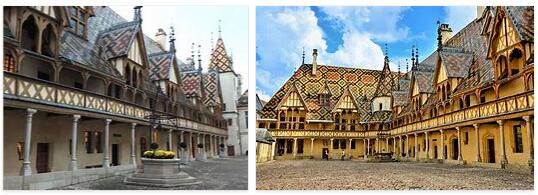Metz
On the trail of a rich history in north-eastern France
In Metz, the Lorraine metropolis on the border with Germany, visitors always walk in the footsteps of history. And it was not only peaceful times that this junction of important European routes experienced. The city was repeatedly affected by the disputes between the two large neighbors, and the checkered past can be seen and experienced at every turn in Metz. It is revealed today in an interesting cultural heritage with a remarkable architecture. A visit to this city is synonymous with a varied journey through numerous epochs.
The cradle of the Carolingians
From 1972 Metz was the capital of the French department of Lorraine until the creation of the Grand Est region in 2016. But the history of this region can be traced back to Roman times. Relics of this era can be seen in various museums in the city, and also in the monastery church of Saint-Pierre-aux-Nonnains. It is one of the oldest churches in France and dates from the fourth century. But Metz was also the cradle of the Carolingians, whose evidence of culture can still be admired. In those years Metz was a cultural hub of the continent with recognized schools and a flourishing handicraft.
An important trading center
During the Holy Roman Empire, between the 12th and 14th centuries, Metz rose to become one of the most important trading centers in Europe. However, the most interesting buildings in the city were built in the 18th century, when France set the tone with its classical architecture. The Palace of Justice, the beautiful theater and above all the imposing Place d’Armes date from this period. That changed with the war of 1870, when Metz lost its French-dominated ambience and neighboring Germany now set the tone. The imperial quarter at the train station in Metz has been preserved from this period. The styles mix here, and if you look closely, you will discover not only Gothic and Baroque but also architectural elements of the Renaissance, Art Nouveau and even Art Deco.
Modern city of art and romantic bridges over the Moselle
Today Metz has earned the reputation of a modern metropolis. It is the seat of an important and nationally valued technology center and it has dedicated itself to art in all its facets to a special degree. The Center Pompidou-Metz with its contemporary exhibits and the arsenal created by the Spanish star architect Ricardo Bofill, a concert hall with highly acclaimed acoustics and decor made of beech and inlays, bear witness to this. Thanks to its extraordinary lighting, Metz was nicknamed “Ville-Lumíere”. Numerous painters, sculptors and photographers line up in the city for the European art fair, which takes place every spring.
Quiche Lorraine and Mirabelle plums
The cathedral Saint-Etienne, visible from afar, which unites two naves, is a mighty structure and a cathedral that is unparalleled in France. The huge windows were created by eminent artists. Among others by Marc Chagall, Herman de Munster and Jean Cocteau. But the city of Metz is not only a traditional attraction for lovers of art and history. It is also home to numerous specialties. Quiche Lorraine was made here, on the banks of the Moselle. Mirabelle plums are offered in any form and the “Féte de la Mirabelle” with cabaret, concerts and parades attracts around 80,000 visitors every year in August.
Beaune
Beaune, a jewel in the gently rolling hills of Burgundy
The historical backdrop of the magical city delights every visitor. Beaune was already a rich city in the 15th century, in which the dukes of Burgundy built numerous magnificent buildings. The most impressive ensemble is the Hôtel-Dieu, a sprawling building that was once built as a hospital and is now a wonderful example of the architectural style of that time. The Gothic church Notre Dame and the Hôtel des Ducs de Bourgogne, a splendid aristocratic residence, are definitely worth seeing. As everywhere in Beaune, one encounters the omnipresent subject of wine, the Burgundian Wine Museum is well worth a detailed visit.
Meeting point for the international wine business
The excellent vineyards around the city have made Beaune an important wine-growing metropolis worldwide. Here, around the capital of Burgundy wines, wines thrive whose bottle prices often exceed the € 100 mark. The Beauner Hospices wine auction takes place every late autumn. The still unfinished wines of the current vintage are sold, the proceeds go to social institutions. The auction is attended by numerous international wine experts and the prices achieved serve as an index for the quality of the harvest year and the price level of all French wines.
A city worth seeing on the way south
Beaune is about 40 km south of Dijon, not far from the major motorways that connect Paris and the neighboring countries to the north with the beaches of Provence and the Côte d’Azur. It offers the wonderful opportunity to interrupt the journey and spend a few hours in the picturesque ambience of this medieval-looking city. Burgundian cuisine is famous and the city’s numerous restaurants are perfect hosts. A visit to the small neighboring communities is also very worthwhile. Savigny-lès-Beaune, Pommard and Meursault are friendly places where numerous wineries invite you to get to know their world-famous wines.
